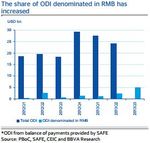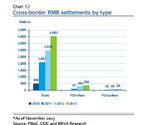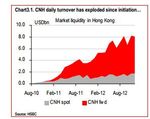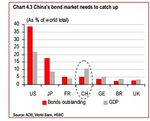Will the Renminbi replace the US Dollar as the world currency? 2013
←
→
Page content transcription
If your browser does not render page correctly, please read the page content below
2013 CRISIL Young Thought Leader Competition (CYTL), 2013
Will the Renminbi
replace the US Dollar
as the world
currency?
Submitted by: Ishan Abrol
Narsee Monjee Institute of Management Studies, Bangalore
1/1/2013Table of Contents-
Executive Summary……………………………………………………………………………..3
Historical Ascent of Dollar……………………………………………………………………...4
Historical Precedent Analysis………………………………………………………………......4
Falling Empire of Dollar………………………………………………………………………..5
Internationalization of Renminbi; Roadmap towards replacing Dollar
…………………………………………………………………………………………………….5
East Asia’s Local
Currency…………...…………………………………………………………………………….7
Critical Analysis………………………………………………………………………………….9
Conclusion………………………………………………………………………………............10
2Executive Summary
The stellar path of the Chinese economy has led Renminbi to play a prominent role in the global
trade and its potential to replace the US Dollar. With the changes in the liberalization policies,
development of financial markets, internationalization of Renminbi and backing the currency
with real asset, Renminbi has already become the East Asia’s Local currency. But close capital
controls, competition by other currencies and less transparent government policies may make the
road bumpier for Renminbi to rise as global currency.
The analysis in this paper is divided into two sections. The first section includes Historical
Precedent analysis with the current situation of China. The analysis illustrates the dominant
position of China in the future. As compared to America in 1920, china has huge reserves which
are not backed by real asset but are denominated in Dollar which will expose China to huge
systematic risk.
In the second section, China’s policy initiatives towards promoting Renminbi as world currency
is analyzed and critical factors affecting the internationalization process are tested. Though
China has taken major steps towards internationalization but China is far behind the US in terms
of strong financial institutional reforms which are must for promoting Renminbi as the reserve
currency.
Currently with the pace of reforms for the internationalization of Renminbi, Renminbi has the
prospects to become an active international currency.
3Ascent of Dollar
Post World War II, for the efficient international trade and stable macro economic conditions,
US pegged Dollar to gold at $35 per ounce of gold which further gave other countries an
enticement to use Dollar as reserve. This was primarily due to the acceptance of gold as the
common medium of exchange at that point of time. Furthermore, in the later half of the
nineteenth century after the World War II, all the currencies in the world were pegged to gold,
which was an advantage for the US Dollar as the gold was denominated in US dollar. Hence post
1945, rising British borrowing in American Dollars and economic weakness of the UK led to the
growing importance of Dollar in the International Trade.
This led the US Dollar to overtake sterling as suddenly every currency became denominated in
Dollar.
GDP Dominance ( 1872 ) Reserve Currency ( 1945 )
Economic Dependence ( 1914 )
Historical Precedent Analysis
Current situation of the Chinese economy overtaking the US can be compared with the Sterling-
Dollar transition phase in the 20th century to know the prospects of Renminbi to replace the US
Dollar.
GNP- In 1890, US had overtaken the British economy to become the world’s leading economy.
But it took more than 40 years for the US Dollar to dethrone the British Sterling to become the
supreme currency in 1944. Over the past decade, China has grown at an average rate of 8% and
is expected to surpass the US economy by next decade. Therefore, Renminbi has the potential to
become the sovereign currency by the next 15-20 years.
Financial Position- Post World War 1, due to the increasing borrowing by British, US became
net creditor and consequently it became the prime exporter in the world. Similarly, in the present
scenario, Chinese economy has become the largest net creditor with more than $2 trillion in
exports while US is on the opposite position. US’ situation is similar to the situation faced by UK
post World War I.
Reserve Holdings- Moreover, growing Chinese dominance in the international trade requires the
trading countries to hold their reserves in Chinese currency. However, Renminbi is not backed
by real assets. In the 20th century, other countries held Dollar because it was backed by gold; to
make Renminbi an international currency; it must be backed by some real asset. Further, it
should not erode the value of Dollar reserves held by China.
After World War II, high debt British economy fell to Americans who held the largest British
debt at that time. Currently, china is the largest creditor to the world. So, if Historical pattern is
an indicator that that the reserve currency would be replaced, then it would be Renminbi.
4Falling Empire of the US Dollar
Despite the reserve currency status of US Dollar, the current macroeconomic and financial
instability in US is adversely affecting the future prospects of US dollar.
First of all, US accounts for 19% of the world GDP in comparison to more than 40% in 1960.
Likewise, the huge decline in exports of goods and services raises the question whether US
Dollar should still be used as a reserve currency which accounts for 60% of the world forex
reserves.
Debt- The current US gross government debt has reached 110% of the GDP. This situation is
similar to situation in 1924 when gross debt to GDP reached to 136% due to the budget deficit,
war financing and Debt. This is reducing the credibility of the world’s largest economy.
Subprime Crisis- The 2008 subprime crisis has led the emerging market economies to
accumulate reserves other than US Dollar to diversify due to which the confidence of the global
markets is decreasing in US Dollar. Quantitative Easing by US Fed is further decreasing the
value of the Dollar foreign exchange holdings and creating a major volatility in the currency
markets.
Petrodollar Arrangement-America was the largest oil importer provided an important incentive
to other countries to peg against Dollar. Being a monopolized commodity, countries producing
oil benefit from Dollar as a reserve currency. Petrol Dollar arrangement is one of the important
reasons for Dollar dominance. However, now China is the largest importer of oil. Bilateral
agreement between UAE & China for oil purchase in Renminbi and growing trade relations with
Saudi Arabia, Russia to establish new oil refineries is challenging the Petro Dollar agreement.
The above discussion clearly illustrates that if the value of the dollar depreciates, US debt
holders will have to pay more and investments funded with US Dollar will value less. All these
factors are not a positive sign for US Dollar to retain its supremacy.
Internationalization of Renminbi; Roadmap towards replacing Dollar
Today, China is not only the world’s second largest economy but also the largest Trading
economy. However Renminbi trade settlement is meager as compared to the growing Chinese
dominance. Hence, it has become necessary for China to internationalize its currency.
5Besides comparing the Chinese Renminbi with the transition of Sterling to Dollar, another
inclination towards Renminbi as a reserve currency is the Chinese internationalization policies.
This will further help the Renminbi to become the trade & settlement currency, a financial
transaction currency and in subsequently replacing the US Dollar in the near future.
Renminbi denominated bilateral swaps- Majority of China’s trade with other countries has
started getting invoiced in the Chinese currency already. After the sub-prime crisis and in order
to internationalize its currency, PBOC (People Bank of China) has entered into Renminbi
denominated swaps worth $300 billion with more than 19 countries, further enhancing the trade
in Renminbi. Recently in October 2013, China entered into Forex Swap with Euro zone with the
transaction size of 350 billion Yuan and 45 billion Euros.
These initiatives have brought financial stability, enhancing liquidity of Renminbi in the foreign
markets, therefore enabling Yuan to become a medium of exchange.
Direct Trading and Financing in Renminbi- Previously, USD was required as an intermediary
currency to trade Renminbi with other foreign currencies but recently China launched a direct
trading platform with Japanese Yen, Australia dollar, New Zealand Dollar and Thai Baht.
Another important initiative has been to allow foreign companies to raise money in Renminbi in
securities market. Institutions such as ADB & IFC have raised money by issuing Panda Bonds
and local Foreign Multinational banks have also issue Bonds in Renminbi.
Foreign Direct Investments- Currently, China represents around more than 9% of the Global FDI
in 2013. More than 50% of the outward foreign direct investment from China is in Renminbi
which shows the paradigm shift of merely trade currency to investment currency. Renminbi
Internationalization and development of offshore Renminbi centers in Singapore, London and
Taiwan are creating more opportunities for Chinese Multinationals for outward FDI in
Renminbi.
Invoicing in Renminbi and establishing of swap contracts with other countries illustrate the
Chinese motivation to become the lender of last resort in times of crisis and liquidity crunch.
Furthermore, it will reduce the exchange rate risk faced by the Chinese companies in the global
markets.
6East Asia’s Local Currency
Recent research has shown that Renminbi has become a dominant reference currency (invoicing
in Renminbi) leading to the De-Facto Renminbi currency block in East Asia. Seven countries out
of the ten countries in East Asia are tracking Renminbi more closely than Dollar due to the rising
trade prospects with china. Emerging markets also account for 67% of the China’s imports and
56% of its exports. It is more beneficial for these countries to have a stable exchange rate with
China. So, presently Chinese Renminbi is becoming East Asia’s local currency. It is too early to
say whether or not in the near future Renminbi will replace the USD worldwide but in East Asia
it has already replaced the USD to a certain extent.
Post 2010, 18% of China’s exports has been settled in Renminbi. Renminbi has become world’s
9th most traded currency in the world in just three years but this number can take a giant forward
leap if china adopts the floating rate currency regime.
7Now, more than 10,000 banks worldwide are offering their customers to settle their trade
transactions with China in Renminbi in comparison to 900 Banks in 2011. The pool of offshore
Renminbi settlement is around $143 billion dollars which has been into existence since 2010.
Now more than 16% of the Chinese trade is settled in Renminbi. Strikingly, Chinese bond
market has grown exponentially from 69 billion Renminbi to 405 billion Renminbi. This
paradigm shift shows the potential of Renminbi to replace the dollar in the long term.
Since 2012, the Chinese Currency market (CNY Market) has become one of the fastest growing
markets worldwide.
Despite being the world’s largest trading nation and the second largest economy, Renminbi’s
share in the global trade compared to major currencies is insignificant. Growing CNY market
and importance of Renminbi in trade settlement are long term initiatives of China to create an
alternative to US Dollar as the world currency.
8Critical Analysis-
The most important question that Chinese policymakers have to answer is: Would the Chinese
Government have more benefits in bringing flexibility in controls in exchange for
internationalization of Renminbi?
China is aggressively trying to internationalize its currency but the policies adopted to do full
internationalization are daunting for a conventional Chinese policymaker. Cost of being a reserve
currency will be higher for China as compared to US or UK because once China liberalizes the
capital controls; it will lead Renminbi to appreciate significantly. It was different in case of US
because being a consumption driven economy and leader in technology exports faced less
currency appreciation pressure. Unlike US, China has a long way before it can become a leader
in technology exports.
China’s export comprises of 48% of the GDP and Chinese Renminbi appreciation will adversely
affect the competitiveness of its export sector and economic growth.
China’s Trilemma- In 1960, Noble prize winner Robert Mundell inferred that a country at one
time can’t have an open capital account, along with control over interest rates and currency. For
a country like China which is having a fixed currency rate and restricted capital conversion, it
will be a very tough task to decide on the tradeoff between giving up of the controls and
Internationalization of Currency.
China needs to have higher financial stability and economic integration than those of US to
replace Dollar.
Apart from the above impediments, there are other roadblocks for Renminbi to become the
reserve currency which can be imputed to the following factors-
1. Dollar as Safe Asset- Post subprime crisis, USD is regarded as the safe haven as it global
turnover increase from 2007 to 2013. But in 1940, post crisis Pound weakened and its
global share also reduces. This further explains the strong belief of the global investors in
the USD.
2. Competition- Earlier US Dollar had no competition other than Pound but Renminbi is
facing competition from the Euro and the SDR (Special Drawing Rights). Euro is the
second largest reserve currency with 23.8% share in the global reserves. Growing
importance of SDR will also challenge the dominance of Renminbi
3. Dollar Dilemma-. To replace the dollar as a reserve currency it is very important for the
Chinese Central Bank to exonerate the Dollar reserves with less volatility in the forex
market.
4. Low Inflation and Macroeconomic stability- To have the macroeconomic stability and
low inflation for the support of reserve currency, a country should have full currency
convertibility and free floating exchange rate.
9It will be a long term goal for Chinese officials to regulate the capital controls because in
a short span, the pegged exchange rate and stringent capital control will lead to the
unsustainable monetary imbalances in the Chinese economy.
5. Depth of Financial Markets- Chinese Securities and Bond market are in its nascent stage.
In spite of the broad steps taken by the Chinese policymakers such as creation of high
yield junk bond markets, introduction of collateral debt swap transaction for private
sector, Chinese bond and securities market is far behind than the developed countries
capital markets. Further, Chinese policy makers also have to take a step to strengthen its
derivative market. Moreover, Global investors are not allowed to take part in the
derivatives or the money markets.
The above factors such as strong political, economic, social stability factors can only make
US economy and Dollar stronger as compared to the Chinese economy. China has to make
major restructuring changes in its whole system to challenge the USD. Furthermore, USD
can be called as the English language of the Forex Markets because most commodities such
as oil are priced in US Dollar just like most people interact in English with each other.
Conclusion-
A conventional wisdom proposes that any successful internationalization process should also
complement with the open policies of the government, relax capital controls, flexibility of
exchange rate and depth of financial reforms. Presently, China is not ready to replace USD in the
near term and if history is any guide, then possibly by the Year 2040, Oil prices reaching 600
CNY/Barrel causing inflationary pressure in countries like India. The MSCI World Index, all the
commodities and Trade will be denominated in the world’s most traded currency.
Internationalization of currency is a multi-stage process which begins with promoting local
currency as a trade currency than the investment currency before becoming the reserve currency.
China is at stage one where it is establishing itself as a trade currency. Thereafter, in the medium
term it will be an addition to the other reserve currency or basket of currencies before dethroning
the US Dollar. Renminbi will become an important reserve currency within the next decade but
prospects of surpassing the Dollar as the reserve currency in the near term doesn’t look so much
probable.
10Bibliography
Arvind Subramanian, M. K. (2012, October). China's Currency Rises in the US Backyard.
Financial Times.
Arvind Subramanian, M. K. (2013). The Renminbi Bloc Is Here: Asia Down, Rest of the World
to Go? Pterson's Institute of International Economics.
BBVA Research. (2013). China’s outward FDI reaches new highs on strong growth in 2012-13.
China Economic Watch.
BBVA Research. (2013, May 27). China’s RMB Bilateral Swap Agreements: What explains the
choice of countries?
Bowles, P. (2011). Renminbi Internationalization: A Journey to Where?
Chuling Chen, R. Y. (n.d.). RMB as an Anchor Currency in ASEAN, China, Japan and Korea
Region1.
DBS Group Research. (2013, March). A global RMB: inventing the necessary.
Dr Zhou Xiaochuan. (2009, March 23). Reform the international monetary system. Bank of
International Settlement.
Eswar Prasad, L. (. (2013). The Renminbi’s Role in the Global Monetary System. Global
Economy and Development at Brookings.
Eswar Prasad, L. Y. (2013). The Renminbi’s Prospects as a Global Reserve Currency. Cato
Journal.
HSBC Global Research . (2013, March). The rise of the redback II. HSBC Global Research.
Lee, J.-W. (2010). Will the Renminbi Emerge as an International Reserve Currency? Asian
Development Bank.
R. Sean Craig, C. H. (2013). Development of the Renminbi Market in Hong Kong SAR:
Assessing Onshore-Offshore Market Integration. IMF Working Paper.
Robert N McCauley, P. M. (2009). Dollar appreciation in 2008: safe haven, carry trades, dollar
shortage and overhedging. Bank of International Settlement.
Ryan, J. (n.d.). China, the Eurozone and Global Reserve Currencies. Centre for Economic
Policy.
Schenk, C. R. (2009). The Retirement of Sterling as a Reserve Currency after 1945: Lessons for
the US Dollar? International Monetory Fund.
UBS Investment Research. (2012, August). From Here To Eternity.
11Vass, T. E. (2013, Feburary 22). The Uncertain Future Of The US Dollar as The Global Reserve
Currency.
Yukon Huang, C. L. (2013). Does Internationalizing the RMB Make Sense for China? Cato
Journal.
Websites and Database
World Trade organization, WTO
International Monetary Fund, IMF
People’s Bank of China, PBC
Seekingalpha.com
Financial Times, FT.com
Forbes.com
12You can also read






















































